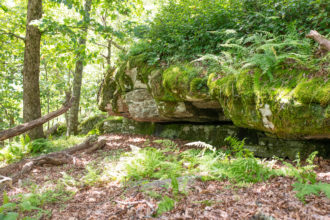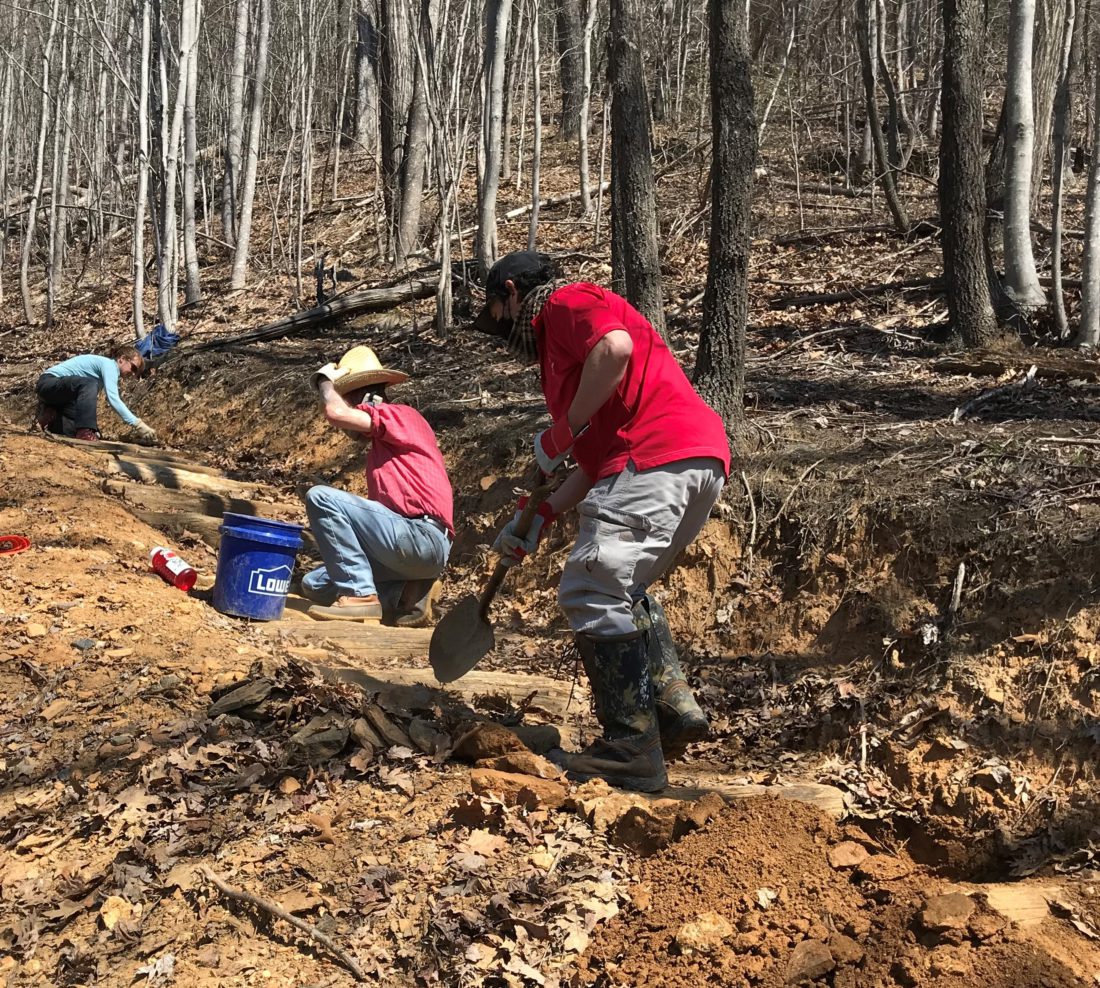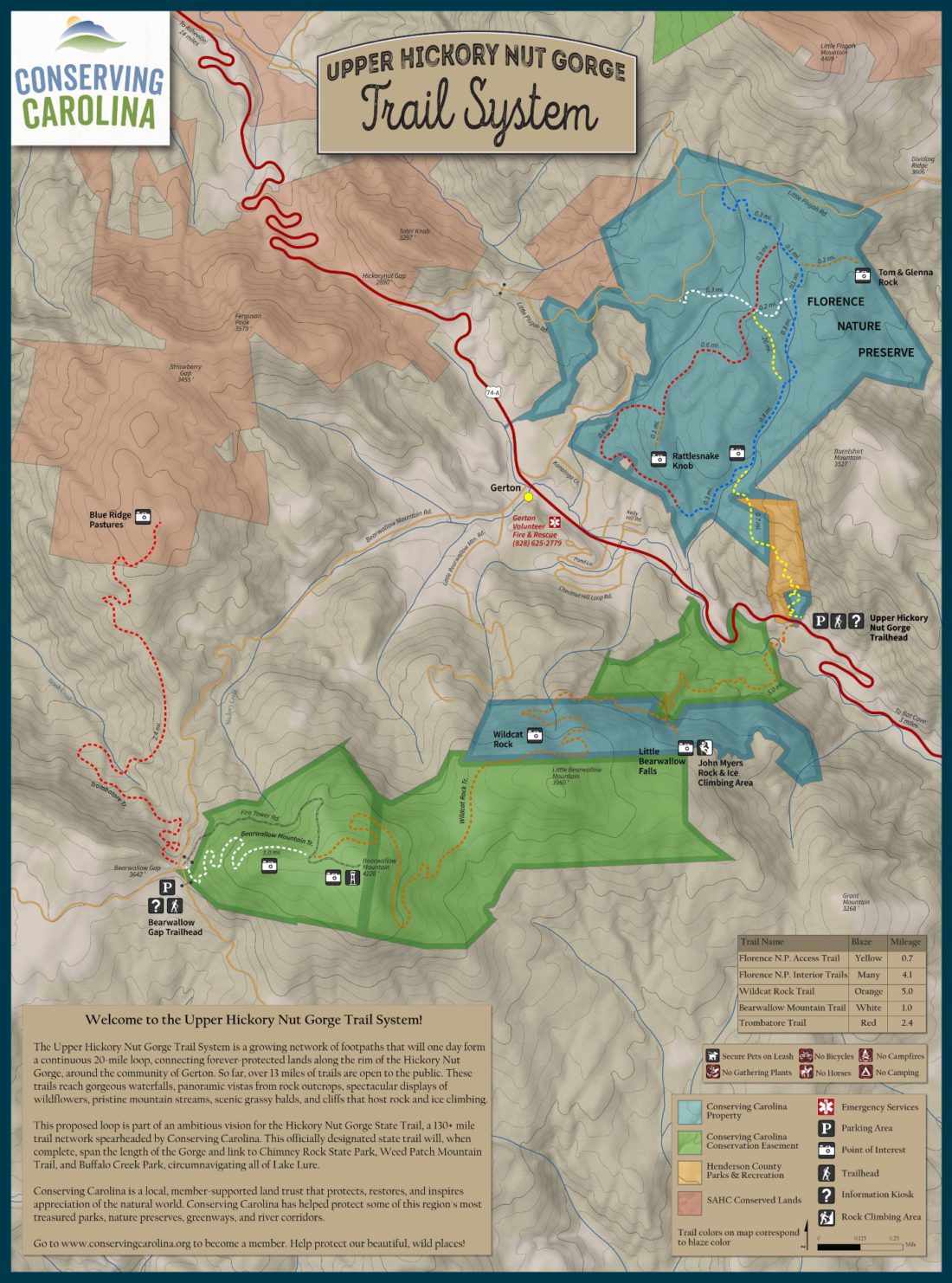Doughty volunteers armed with shovels, hoes, rakes and sledgehammers are building trails through scenic Hickory Nut Gorge as part of a campaign to both preserve wild places and provide better access to them.
A cooperative effort by Conserving Carolina, state and local governments, other nonprofits and the general public is gradually developing the Hickory Nut Gorge State Trail in and around the rugged terrain that lies just beyond Buncombe County’s southeastern border. Already, hikers and mountain bikers can enjoy miles of trail and thousands of acres of protected land. One segment, the Weed Patch Mountain Trail, has received national recognition, and the gorge — which runs through Henderson and Rutherford counties, just a 25-minute drive from downtown Asheville at its closest point — is an increasingly popular hub for outdoor recreation.
That’s a huge turnaround from 15 years ago, when access to many of the area’s waterfalls, cliffs, bluffs and hardwood forests seemed destined to become limited to people wealthy enough to live in a gated community. In the 2010s, people were taking helicopter rides to pick out homesites to buy north of Lake Lure, and developers appeared poised to put McMansions on every other privately owned peak or ridge in the vicinity.
There were plenty of “No Trespassing” signs around the communities of Gerton, Chimney Rock and Lake Lure, and little publicly accessible land apart from the 600-acre Florence Nature Preserve, which was deeded to Conserving Carolina incrementally in 1996 and 2001. For the most part, taking a walk in the woods might have required owning them, paying to visit the then privately owned Chimney Rock Park or asking around about which property owners didn’t mind an occasional hiker traipsing through.
“It was just local knowledge and a wink and you head out,” remembers Jerry Stensland, president of the nonprofit Rutherford Outdoor Coalition.
A biodiversity hot spot
Public access to the outdoors around Lake Lure was “lagging behind in a lot of ways, given the natural resources we have here,” says Larry Czajkoski, a veteran member of the town’s Parks and Recreation Board. “When people come to this part of the world … one of the first questions out their mouths is, ‘Hey, where can we go hike?’”
Now, instead of walking between souvenir shops, people can walk trails offering stunning views and highlighting different aspects of the area’s diverse landscape. Hikers might visit a waterfall offering ice climbing in the winter and scenery year-round, or rock outcroppings where they can traverse a cave formed by fallen boulders. The breathtaking scenery includes the Craggy and Black mountains to the north, Lake Lure at their feet and much of North Carolina’s foothills and Piedmont stretching seemingly forever to the southeast.

The gorge is a deep slash in the earth with a swift stream flowing down the middle, steep slopes and cliffs on either side and, curiously, nearly flat valleys tucked behind ridges away from its center. In a reference to the Lord of the Rings books and movies, Conserving Carolina’s Peter Barr playfully calls it the “Gates of Mordor to the North Carolina mountains.” Kevin Adams’ definitive book, North Carolina Waterfalls, lists 12 named waterfalls and cascades in the area.
Barr, Conserving Carolina’s trails specialist, has been a driving force behind the nonprofit’s growing network. He calls the gorge “a biodiversity hot spot because of its considerable and abrupt change in elevation between the high country of North Carolina and the Piedmont.”
A 2006 study conducted for state government said the area that’s spread across parts of Buncombe, Henderson, Polk and Rutherford counties has national significance for its unusual natural communities. According to one count, 37 rare plant species and 14 rare animal species can be found there.
The Tom Sawyer method
North Carolina’s state trails program uses the same strategy to expand the network that Tom Sawyer employed to get a fence painted in the Mark Twain novel: Persuade someone else to do it. Once the General Assembly authorizes a trail, the state develops a master plan identifying a wide corridor within which it might go; after that, it’s primarily up to nonprofits and local governments to make it happen.
“We figure out what can and can’t be done … then the partners that actually are developing the trails” acquire land or property easements, develop more detailed plans for individual segments and eventually start building, state trails planner Smith Raynor explains.
Conserving Carolina was formed in 2017 from the merger of two local land trusts, the Carolina Mountain Land Conservancy and the Pacolet Area Conservancy. The former played a key role in the creation of Chimney Rock State Park, which takes in much of the lower end of Hickory Nut Gorge. In 2005, notes Barr, members of the organization’s board put up their homes and retirement savings as collateral to enable it and The Nature Conservancy to outbid a developer and acquire the 1,568-acre Worlds Edge tract south of Chimney Rock Park. The two nonprofits subsequently sold the Worlds Edge property to the state.
Soon after, North Carolina bought Chimney Rock Park, which had been operated for decades as a private nature preserve. The two properties were then combined to create Chimney Rock State Park. A subset that’s now called Chimney Rock at Chimney Rock State Park is operated by a concessionaire that charges $17 admission per adult, but hundreds of acres in and around Hickory Nut Gorge that are also part of the state park are open to the public for free.
In 2009, Conserving Carolina volunteers broke ground on what became the first segment of the Hickory Nut Gorge State Trail to be completed: an easy path to the top of Bearwallow Mountain. The high peak is crowned with a pasture offering expansive views. The trail was made possible by an easement acquired from the owners of what’s still a working farm, and the transaction, says Barr, “served as proof of concept that to have a trail you don’t have to sell your land or relinquish the rights to your property.”
Tapping both volunteer and professional labor as well as state and federal grants and private donations, Conserving Carolina has gradually expanded the trail network, linking Bearwallow Mountain to U.S. 74A via similar easements or land purchases. The final piece of a route between Bearwallow and Florence Nature Preserve in Gerton was completed last year. And a stretch of trail that’s scheduled to open this summer will connect Bearwallow and Hickory Nut Gap on the Buncombe/Henderson county line.
Step by step
But the most spectacular path the organization has built in the area is the Weed Patch Mountain Trail, which runs 8.6 miles along a high ridge north of Lake Lure that features spectacular rock outcroppings. The steeply sloping land was supposed to be part of the GreyRock subdivision, but after the developer went bankrupt in 2008, Conserving Carolina bought about 2,000 acres. The Grey Rock that gave the development its name is one of the highlights of the footpath, which opened in 2018. Both Weed Patch and one of the Bearwallow segments won national awards from The Coalition for Recreational Trails.
The western end of the trail lies in Chimney Rock State Park, and short stretches wind through private property, but most is on land that Conserving Carolina sold to the town of Lake Lure in a deal funded largely by state grant money. The town land is now Buffalo Creek Park, which at more than 1,500 acres is one of the largest municipal parks in the state.
It’s taken state government a little while to catch up with these impressive efforts. The General Assembly authorized creation of the Hickory Nut Gorge State Trail in 2017, and the N.C. Trails program recently completed the public comment phase of the process of fashioning a master plan for the project. Raynor expects the plan to be finished by the end of this year.
A map of the trail concept looks like an unbalanced barbell. One circle that includes the Bearwallow trails lies in the upper Hickory Nut Gorge. A trail paralleling U.S. 74A will connect it to a bigger circle of peaks overlooking Lake Lure, including the Weed Patch Mountain Trail. Different sources say the fully realized state trail could run anywhere from 60 to 100 or more miles long.
Within the broad corridor identified by the master plan, the state and Conserving Carolina will work with willing landowners to develop the actual routes. When they run into a dead end in one spot because a property owner is reluctant to sell or donate land or an easement, they look for alternatives or simply work on a different section.
“We are not going to impose this on anybody,” stresses Raynor.
Everyone involved says completing the trail will take many years. “If we waited until we knew entirely how we were going to create … a trail, we’d never get started,” says Kieran Roe, the land trust’s executive director. “You just have to go with opportunities over time, then you figure out how to connect things one segment at a time.”
Building trails and conserving land go hand in hand, he maintains. Routing trails requires protecting at least some land on either side, and protecting land from development spurs public demand to see what’s there. “It helps our mission when people are able to get out and enjoy places we have conserved,” he says.
Built to last
On a sunny March Wednesday, the Rock Crushers crew — nine volunteers and two Conserving Carolina employees — climb the side of Youngs Mountain, northeast of Lake Lure, to work on a roughly 2.5-mile segment that’s set to open in late April. One of the day’s tasks is to pound stones to golf ball size, dump them into steps formed by locust logs, then cover them with a thin layer of dirt.
The resulting steps aren’t likely to wash out in a heavy rain, says volunteer Stefan Israel of Fairview. An old logging road runs just a few feet away, and initially it would have been easier just to route the trail over it, but staffer Kelly Waldron says that’s not how Conserving Carolina does things. Logging roads aren’t usually built to last, she explains.
Conserving Carolina takes a long-term approach, notes Barr. Many Western North Carolina trails run in a straight line with a steady grade and intermittent water bars — small logs or rocks laid at right angles to the trail’s direction — to divert water and reduce erosion. But if those measures fail, sediment can flow into streams, and trails fill with loose stones that can be tedious to walk on.
Instead, the nonprofit’s trails undulate up and down and from side to side, which Barr says creates many more opportunities for water to drain and reduces maintenance needs. “Straight trail is bad trail; curvy trail is good trail,” he declares.
These days, the group relies on a hybrid model. Barr or another pro crisscrosses the land and decides on a route, volunteers help move brush out of the way, and a professional trail builder uses a small mechanical excavator like a Bobcat to create the trail tread. Volunteers take it from there.
“It’s really fun to do volunteer work that’s going to last,” says Hendersonville retiree Kim Chao. “If you come back five, 10 years from now, our work is going to be there.” She and her husband, Bob Carlson, are longtime Rock Crushers members.
There is a downside, however, says Israel, an avid hiker. When walking for pleasure on a trail he’s helped build, “You can discipline yourself and resolve I’m not going to fix anything, but it’s always a temptation.”





I was recently told that the area known as “the Lost Colony of Henderson county” had opened up as part of the trail system. I had read so much about it and looked for a long time to find it and finally did some years ago but it was not very accessible then. Is this part of the Skyline Trail from Chimney Rock? I have read that was part of the area known by that name and that a creek running through the property was the origin of Hickory Nut Falls. I am native of Henderson county but have not lived there for some time but enjoy coming back from time to time and exploring areas I grew up in. Thank you!